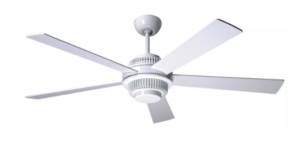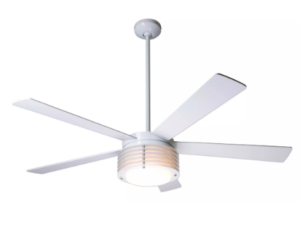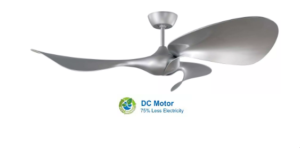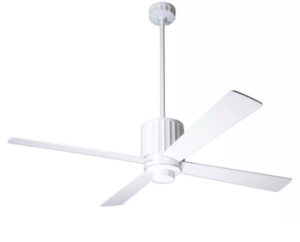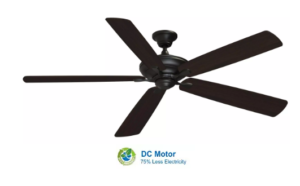What is a garage ceiling fan? It is essentially a ceiling fan is waterproof, durable, and built specifically to withstand the potentially harsher environments of a garage. Of particular importance, garage ceiling fans have damp ratings. This means that that these can handle a bit of moisture or dust, making them perfect for a garage setting that might be used for parking a car, storing goods, or doing home office projects.
We kept this in mind and reviewed the best ceiling fans that carry a damp rating so that you can focus on what matters: cooling your home garage.
We also selected long blade spans as most garages tend to be larger than your average room within a house. In the U.S. garages are usually the width of one or two cars. Therefore, a fan with larger blades can add more value here in ways that it can’t within a home.
Some garage’s don’t need ceiling fans. Rather, they need floor fans or better insulation. Others need windows for enhanced circulation.
If you are looking to cool your garage, the fans outlined here are all candidates to help. They are robust, reliable, water-resistant, aesthetically pleasing, and generate strong air-flows.
We hope you enjoy our top picks for the best garage ceiling fan. Read our buyer’s guide at the bottom of the page for even more information on all things garage ceiling fans.
The Modern Forms Aviator is a high performance (11,779 CFM against a 5,000 CFM avg) all-weather ceiling fan. It can easily handle rain, heat, sleet and snow and can be easily washed off with a hose. Thus, it makes a perfect attic ceiling fan or an outdoor fan. The 70” aerodynamic blades produce a strong and effective cooling breeze across a large room. The powerful DC motor will run smooth and quiet for years while saving you on energy bills over time.
The optional LED Lights have a twist lock system for easy installation. A mouth blown triplex glass gives a brighter illumination. The WiFi-ready fan comes with a full function Bluetooth wall control that improves the range at which ordinary control works. The remote can also control multiple fans which is terrific.
The Modern Forms fans are the new leader in the ceiling fan technology. Their fans, like this model, work with almost all of the smart devices, both Android and Apple. The Aviator series is top notch in style as well as quality to meet both indoor and outdoor requirements.
The Mordern Forms Morpheus Ceiling fan is fully smart and WiFi ready. The fan is compatible with Google Assistant, Amazon Alexa, Nest, Ecobee and Samsung SmartThings to run on voice commands. You can either go wireless or use a wall control that features 6 speeds and a full range light dimmer. The control requires only a single hot wire to install.
Each fan includes an energy saving dimmable LED light. The DC motor present is EnergyStar qualified that saves more power than an average AC ceiling fan. The model is UL rated to use in outdoor wet locations for both covered and uncovered areas. Even exposure to heavy rains won’t damage its exteriors. Thus, it can function as a garage ceiling fan without any cause for concern.
The Modern Forms fans are fairly new in the market with competitive and over the edge technology in the fan industry. For homes and offices that want technologically savvy interiors, the Morpheus ceiling fans will be the ideal bet.
The Modern Fan Solus in Gloss White is customizable with multiple blades and light options. The fans are well designed and can withstand harsh weather conditions. Thus, serving as a garage ceiling fan is no trouble at all for it! They are UL rated for both indoor and outdoor lounge and living areas. Though you get a primary 3 speed wall control, other control options are also available.
The fan has sleek cage-like grillwork and contemporary lines to amplify your existing room decor. This model produces the best cooling breeze at 3.4 MPH, even if you are not sitting directly under its blades. With an airflow of 5878 CFM you can expect even distribution of air within a room whether outdoor or indoor.
The Modern Fans Company have pioneered in creating the latest design ceiling fans with most advanced features. They also commit on quality within reasonable price rates. The Solus range was released in 2014 and still is one of their bestsellers for its impeccable performance.
The Modern Fan Pharos is a contemporary ceiling fan with attractive light fixtures. It has a single light fixture with frosted opal glass. The frosted glass gives a diffused ethereal luminance to your interiors. The fixture uses 3×40 watt Candelabra bulbs that can be used in both dry and damp locations. The average airflow at 5035 CFM is ideal for areas with minimum cooling requirements. While this makes for a great garage fan, it’s beautiful design is also a beautiful addition to almost any small to medium size room in the house.
The fan features a 188mm x 15mm DC Motor that saves energy and works smoothly under power fluctuations. The 3 speed hand held remote control can be used for both halogen and incandescent lamps. It also comes with a wall hanging bracket for better convenience. However, the remote cannot be used to control more than one ceiling fan.
The Modern Fans are aimed for the modern contemporary homes. The company stresses over better energy efficiency and design value for all its models. The Pharos is one of the most affordable ceiling fans they offer that has both style and terrific functionality amongst rest fans in the market.
The Craftmade Fluid ceiling fan will turn heads. The fan is available in four fabulous designs and colors to amplify your indoor or outdoor space. The 54” blades are twisted to give it a retro look and will be perfect for small intimate spaces.
The DC Motor not only makes it super efficient but also proves to be durable in long term. The Fluid is so cost-effective because it uses only 38.7 watts per hour at high speed. The overall efficiency is 153CFM/Watt which makes the fan three times more efficient than average AC ceiling fans.
Craftmade fans are known to create funky and sometimes over the top designs that immediately uplifts the décor of the entire room. The Fluid series is very much inspired by the retro décor with the use of pastel colors and seamless designs. The fans are more geared towards aesthetics and it makes the model highly sought-after amongst buyers.
The Monte Carlo Lily Ceiling Fan comes with rubberized white blades that allows less friction and adds more longevity to the device. The blades come at a 14 degree blade pitch to produce airflow of the highest rating (5/5) among fans in the same price range. An integrated LED Fixture encased in a clear frosted glass diffuser doubles its beauty.
The fixture illumination is not harsh due to the diffuser and creates a soft focus. The 12 Watt LED fan serves its purpose for both dry and damp locations. With 7301 CFM airflow, the fan scores above the average to save upto 40% on your AC bills. The fan features a 120mmx25mm DC motor to save you even more energy. It comes with a damp rating so it can be used in any garage without cause for concern.
Founded in 1996, Monte Carlo emphasizes on fashion-forward and trend-inspired solutions for homes and offices. The Lily ceiling fan series is one of their most loved and affordable fans that never disappoints.
The Modern Fan Flute Ceiling comes with various light fixture options to give you an upper edge customization. The vertical orientation of the die-cast body can house either a 26- watt compact fluorescent lamp or a regular incandescent bulb. The fluorescent light is ideal for long time usage as each lamp can last for at least 10,000 hours.
The fan utilizes an energy efficient DC Motor. Even the fluorescent light fixtures consume 75% less energy than an equivalent incandescent light bulb. The fan operates by a 3 speed wall control while other types of control options are also available. The 52” blade span is ideal for small to medium sized rooms. It is damp rated to work perfectly in any garage.
The Modern Fans create versatile transitional designs to suit any setting. The Flute ceiling fans is one of their highly energy efficient and universally flattering designs that can fit into any space.
The Fanimation distinction ceiling fan comes in varying blade spans ranging from 54”- 72” to suit different types of room space. With customized blades and light fixtures, it suits any decor. It is a traditional extra large fan that serves very large spaces, hallways, porticos and balconies, and of course, garages.
The model is EnergyStar qualified and damp rated to suit both outdoor and indoor. The high efficient DC motor coupled with 14-degree blade pitch gives an average airflow (4998 CFM) while saving your AC bills. You get a 31-speed Bluetooth remote along with other control options. You can also download the Fansync app on your smart device to control this fan via Bluetooth.
The Fanimation Company is a gold standard in the fan industry. Their designs target every décor and come budget-friendly. The Distinction model is a great buy for any type of room setting which makes it even more highly sought-after amongst home owners.
The Modern Forms Aviator comes with smart features and exceeds the current efficiency standards. You can operate the fan from anywhere with its WiFi smart app which has learning capabilities to adapt to your lifestyle needs. It can connect with various home automation systems via Amazon Alexa, Google Assistant, Samsung Smart Things, Nest and Ecobee.
Its super efficient DC motor consumes 70% less electricity than a typical AC motor fan. The fan consumes only 30watts/hour even at high speeds, saving a lot on AC bills. The model also includes an energy saving dimmable LED Light. With an above-average airflow of 6321 CFM, it is an excellent choice to provide a decent breeze across a large room.
The Modern Forms is a fairly new member in the fan industry yet creates fashionable designs with most advanced features. Its Aviator model is a far cry from the conventional fans we knew but only better.
The Fanimation Custom Wrap is a sophisticated garage ceiling fan with multiple blade finish and motor combinations. The light kits are also sold separately to make the customization even more flexible. It is EnergyStar qualified to save energy even when used in multiple rooms for long hours.
The high efficiency DC motor performs well both indoors and outdoors. You can operate by a hand-held remote, a wall control or a smartphone. To enable smart control via Echo or Google Home, you need to purchase the WFR receiver separately. It’s also compatible with Ecobee, Nest, Smart Things and others.
Fanimation is one of the most popular fan making companies in the market known for its energy-efficient products. Its Custom Wrap model is available in two variable blade sizes ranging from 44” to 84” to suit every interior. It’s an ideal purchase to complement your Smart Home.
Modern Forms Wynd comes with 60” all-weather blades and stainless steel body to withstand harsh outdoor climatic conditions. This is a smart and WiFi ready model that can be operated through a wall control, WiFi touch panel or a mobile application. It is also compatible with smart voice assistants such as Google Nest, Amazon Alexa, SmartThings, Ecobee, etc.
It is UL rated for indoor and outdoor performance including rain and snow. Moreover, you can easily clean it off using a hose. The DC motor inside saves 70% of your AC bills and delivers air at a terrific airflow of 7160 CFM speed. Its efficiency rating is 211 CFM/Watt, ensuring you more CFM per less watts consumed.
Modern Forms fans are best known for their energy-efficient DC motors which save energy without compromising its quality delivery. With a quality rating of five out of five, Modern Forms Wynd clearly meets your air requirements while amplifying your existing décor at the same time.
This Ball Flush Mount fan is a Ceiling Huggers style model from Modern Fan that is perfect for any low-ceiling environment. The teardrop shape gives it a graceful look and a connectedness to the space. The aluminum color blades blend well with any optional light fixture to aid your room décor.
Inside of it present is a 153mm× 18mm DC motor to rotate 5” blades to produce a decent airflow. It is UL rated for indoor and outdoor damp locations but not for wet areas. The model comes with a basic hand held remote control to manage speed. However, it can control only one fan at a time.
Modern Fan offers five years limited motor warranty on all its fan motor which makes the company highly sought-after in the market. This Ball Flush model impresses further with its decent performance at a price much lower than costly counterparts.
Emerson Loft Ceiling Fan flaunts a barbeque black body and same color ABS blades to amplify your indoor and outdoor décor. You can install it either in a dry or damp location. With 60” blade span and 190 RPM maximum speed, the AC motor inside produces air to blow your socks off. The airflow quality is terrific at 7579 CFM against 5000 average. This beast of a fan is perfect for cooling down a large garage with its damp rating and large blade span.
You can expect a decent breeze under its blades as the wind speed factor is just above-average (3.41 MPH). Despite running on an AC motor, it is Energy Star qualified (Including the lights) to save you up to 70% energy similar to a DC motor fan.
Emerson’s pioneer budget-friendly product designs always impress users both indoor and outdoor. However this model comes with brushed nickel finish for indoor and damp applications only. Nevertheless, it’s a best budget-buy fan under $300 category.
Minka Aire Simple in Coal flaunts ABS all-weather blades and a super efficient DC motor to offer bespoke performance under wet conditions. The motor runs at six different speeds at a maximum 191 RPM to deliver above-average airflow of 5670 CFM. It’s perfect for a large garage.
As it runs on a DC motor, it consumes only 33 watts per hour thereby saving you 70% of your energy bill compared to an AC model. You can control with a remote that has forward and reverse functions but no light dimmer. The optional LED light kit gives you a full scope of customization to meet your design requirements.
Most Minka Aire fans are designed to withstand tough weather conditions including snow and rain. The 52” Simple in Coal model is also UL Wet rated and can perform well in dry, damp or wet location, including rain and snow. Indeed, it is one of the best-buy fan models under $350 in the market.
The Monte Carlo Cyclone Ceiling Fan is UL Wet rated. Thus, it is an ultimate choice for outdoor damp and wet applications. It’s perfect for a garage. Even exposure to heavy rain, snow and wind won’t hamper its body and performance. With a powerful 212mm x 25mm DC motor inside, it moves air 8270 CFM airflow (Avg is 5000 CFM) to give you an instant cooling effect.
Its efficiency rating is 100 CFM/Watt which will save you money on your energy bills in the long term. Operating the fan is very simple with a 3 speed pull chain. In a transitional style, this fan also offers optional light fixtures to amplify your décor at your preferred color temperature.
Monte Carlo has served for decades now paving way to innovative designs. Their fans are made to last for generations just like the Cyclone ceiling model. With little maintenance and better efficiency, this fan is a sure hit.
As an affiliate partner, we may earn from qualifying purchases made on these products.
Garage Ceiling Fan Buyer’s Guide
Are you unsure what to look for when purchasing a garage ceiling fan? I’ve got you covered! In this buyer’s guide, I will show you the factors and features you should consider when purchasing a garage ceiling fan.
Style
First, consider the style of the garage ceiling fan that you want. These days there are lots of different styles when it comes to garage ceiling fans, giving you plenty of choices! Do you want a sleek and modern fan? Maybe you want something more traditional? Maybe you want a unique style that will be a focal point in your garage? Ask yourself these questions to narrow down your search.
When it comes to your garage ceiling fan, you want one that is stylish, but also practical. In newer and modern homes, I recommend opting for a modern-looking ceiling fan. Clear, sharp lines and an aluminum garage ceiling fan will work well here.
For older homes, or those with a more traditional style, you can opt for a large ceiling fan with large wooden blades. This will work well with the existing style of your home, but will still be stylish! Spend some time considering the style of the garage ceiling fan that you want to make the right choice for you.
Controls
Another factor to consider is the controls for your garage ceiling fan. Will the fan be controlled by a panel on the wall? Is there a wireless remote you can use? Or does it need to be wired to a switch on the wall?
Think about what would work best with your garage. If you want the fan to be switched on as soon as you enter, flicking a switch might be easier. However, you might prefer a panel on the wall that offers more control. Remotes to control a garage ceiling fan are handy too, especially if they have a good range. But you do need to consider how you will control the fan if you misplace the remote and how easy replacements are to purchase.
Damp-Rated
You also need to consider whether the garage ceiling fan is damp-rated or not. Ceiling fans for use in garages need to be damp-rated to ensure they are safe for use in garages. Garages are notorious for dampness which can be problematic for any electrical items you are putting in your garage.
A damp-rated ceiling fan won’t rust when it is exposed to moisture and will continue to work as normal. These fans can come into contact with air moisture, but should not be exposed to any direct water, like from rain or a tap. So if there’s a leak in your garage, make sure you fix it before you add a garage ceiling fan!
Number Of Blades
Another factor to consider is the number of blades. The fewer blades a fan has, the quicker it will work to cool down the air and dispel any fumes. Practically, a three-blade fan is a good choice for a garage ceiling fan if you want it to work quickly. If you have a larger garage, it’s best to opt for a four-blade garage ceiling fan.
Some garage ceiling fans will come with more or fewer blades, but typically they come with three or four, meaning you don’t have a lot of options to choose from. In larger spaces, large blades will work well at cutting through the air, and they won’t look out of place on a large ceiling.
However, a small ceiling fan could look ‘lost’ on larger ceilings, and it will be harder to feel the effects. When you consider the number of blades a garage ceiling fan has, consider also the size of these blades and the fan overall before making your purchase.
Noise
Ceiling fans omit some noise, even those claiming to be silent, but it is still a factor to consider when making your purchase. If your fan will be on often, especially early in the morning or into the evenings, consider if the noise will be an issue for anyone. Does your garage share a wall with any neighbors? Or do you have a bedroom directly above the garage?
These spaces are likely to hear the sound of a loud fan, especially at night when the rest of the house is quiet. In these cases, look for garage ceiling fans that are described as quiet. You can check their decibel (dB) rating too and reviews from other customers to find the quietest garage ceiling fan for you.
If you spend a lot of time working in your garage, I recommend looking for a fan that runs as quietly as possible. That way the sound won’t distract you from your work or give you a headache by the end of the day!
Light
Some garage ceiling fans come with a light fitted. Consider if this is something you want for your garage. If you don’t currently have a light in your garage, then a ceiling fan with one included is a good option. Plus it saves the need to buy a separate fan and light!
If you already have a garage light, it might not be as important to you to add more light into the space. Consider where the ceiling fan will be placed in your garage. Will it interfere with an existing light? If so it might be better to opt for a ceiling fan with a light included.
Price
Finally, you should consider the price. Garage ceiling fans come in a variety of prices, from super affordable to super expensive. It’s best to set a budget before you search for one so that you can narrow your search, and not fall in love with a ceiling fan that you can’t afford!
When setting your budget, consider what features are important to you. This can help determine how much you will need to set aside for your garage ceiling fan. Consider how much you can afford to spend too. These days, there is a garage ceiling fan for every budget, so you don’t need to sacrifice what you want from your ceiling fan






